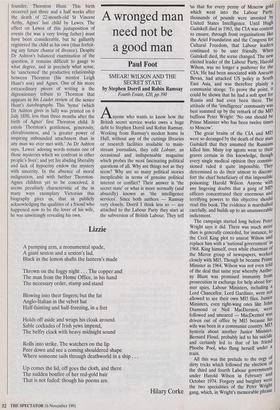Not just a domestic prop for a genius
Beryl Gray
G.H. LEWES: A LIFE by Rosemary Ashton Clarendon Press, £25, pp. 369 or a very long time, George Henry Lewes' reputation has centred on the fact that, for the last 25 years of his life, he was George Eliot's partner. Not a vast number of people have cared to know very much more about him beyond an idea, perhaps, that he was a rather free-wheeling journal- ist who produced a Life of Goethe, and that he was free-thinking and — at least until he took up with George Eliot — somewhat free-living. It is gratifying, there- fore, that this highly intelligent, quick and versatile, immensely fair-minded man who loved science as much as he loved letters, should at last be presented in his own light. Rosemary Ashton is right to reclaim for him, and to reassess, both his actual achievements and his energetic (sometimes almost reckless) thrusts at achievement. Lewes was not a success as the novelist he tried to be,' and he showed limited flair as the actor he wanted to be. But he was not entirely a failure as a play- wright, and he was an influential, often dazzling theatre reviewer (a sort of model for Shaw) and literary critic. He was also a biographer, an extremely lucid philosophic expositor, an excellent mimic (and anec-
dotalist, apparently), and a popularising biologist. He died leaving the final two volumes of his five-volume Problems of Life and Mind — 'a comprehensive study of the human organism, physiological and psycho- logical', as Dr Ashton describes it — for George Eliot to complete. There was a haphazard, reeling element in the remark- able diversity of his prodigious output, though, and for this reason I think it will always remain the case that initial (though no longer, I hope, overwhelming) interest in him will continue to spring from his association with George Eliot: as he anchored her in life, so does she anchor him in history. And so the extent to which his enquiries and enthusiasms parallel hers before they came into each other's lives is striking and enhancing: not only did they work independently on Spinoza, he on an essay, she on a translation — but they were both fervent admirers of George Sand, not for her sexual freedom, but for what they each felt was her spirit of truthfulness. Something of their future response to each other was inherent in their response to Sand's work.
Later, when they were together, just as he supported her in her long, sometimes despairing literary struggles, so did she enter wholeheartedly into his mental worlds. While he was researching his Sea- Side Studies, for instance, she accompanied him on, and described, his zoological expeditions on the shores of Ilfracombe, Tenby, the Scilly Isles and Jersey. She rushed with him every morning to see whether there had been any mortality among the zoophytes and moluscs and annelids they had collected the previous day, and which they kept in 'yellow pie- dishes, a footpan, glass jars, and phials', she joyfully wrote to an old friend. She referred to his work as 'ours', and the collaboration was perfected when her own first fiction (Scenes of Clerical Life) — which she would never have produced without Lewes' encouragement — began to appear in Blackwood's Magazine alongside Lewes' essays.
The fruits of most of Lewes' professional labours are more or less easily accessible. Less accessible is evidence of his legendary sexual deeds, and his biographer properly refuses to translate the plentiful contempo- rary (and not-so-contemporary) gossip as proof that 'he certainly did very much as he liked', as the publisher George Smith put it. Lewes and his wife Agnes did live some- what unconventionally, but the question of the 'openness' of their marriage itself remains open.
Perhaps the smoke of scandal indicates some sort of fire; but Dr Ashton emphasis- es — and quotes Lewes himself on — 'the calm happiness' of the first years of his domestic life. 'My wife and children are dearer to me than ever,' he wrote in April 1847 — six years after his wedding, and three years before Agnes delivered her first child by Lewes' friend and Leader co- founder, Thornton Hunt. This birth occurred just three and a half weeks after the death of 22-month-old St Vincent Arthy, Agnes' last child by Lewes. The effect on Lewes of this juxtaposition of events (he was a very loving father) must have been considerable, but he gallantly registered the child as his own (thus forfeit- ing any future chance of divorce). Despite Dr Ashton's balanced examination of the question, it remains difficult to gauge to what degree, and in precisely what sense, he 'sanctioned' the productive relationship between Thornton (his mentor Leigh Hunt's son) and Agnes. One of his more extraordinary pieces of writing is the digressionary tribute to Thornton that appears in his Leader review of the senior Hunt's Autobiography. This 'hymn' (which Dr Ashton gives in full) was printed on 6 July 1850, less than three months after the birth of Agnes' first Thornton child. It extols Thornton's gentleness, generosity, chivalrousness, and 'a greater power of inspiring unbounded attachment than in any man we ever met with.' As Dr Ashton says, 'Lewes' adoring words remain one of those mysteries which we confront in other people's lives'; and yet his abiding liberality and lack of hypocrisy endow the mystery with sincerity. In the absence of moral indignation, and with further Thornton- Agnes children yet to be conceived, it seems peculiarly characteristic of the in many ways exemplary Victorian this biography gives us, that in publicly acknowledging the qualities of a friend who happened now to be the lover of his wife, he was unwittingly revealing his own.











































































 Previous page
Previous page